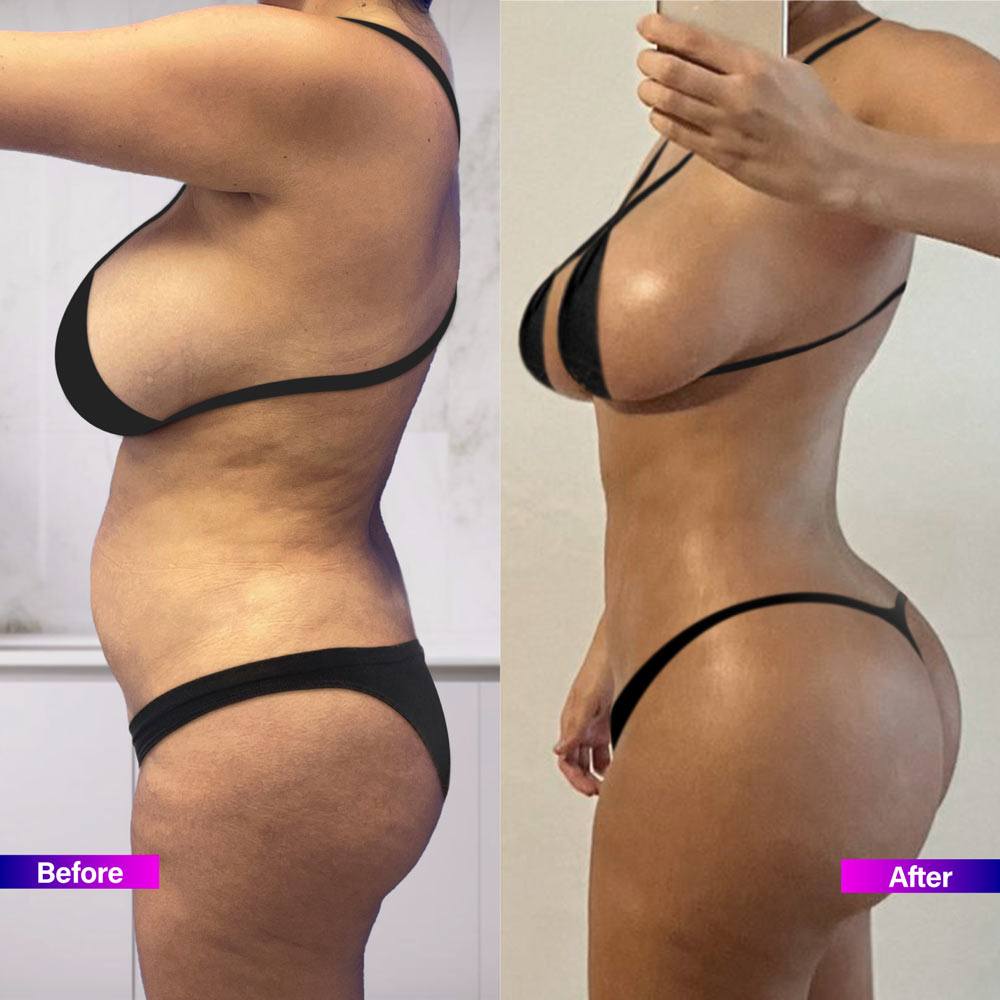IN THIS ARTICLE
Breast Augmentation or Mammoplasty
Breast augmentation, also known as augmentation mammoplasty, is a surgical procedure designed to enhance the size, shape, and appearance of a woman’s breasts. The history of breast augmentation dates back to 1895, with significant advancements over the decades in both surgical techniques and implant materials. This procedure is often sought for cosmetic reasons to improve body image and self-esteem, as well as for reconstructive purposes following mastectomy or injury. The development of breast implants has evolved significantly since the early attempts using materials like glass balls in the 1930s. The introduction of silicone gel implants in the 1960s marked a major advancement due to their more natural feel. By the 1990s, saline implants provided a safer alternative, and by the 2000s, cohesive silicone gel implants, often referred to as “gummy bear” implants, became popular for their durability and natural appearance. Technological innovations such as 3D imaging and robotic-assisted surgery have further refined the procedure, enhancing precision, reducing recovery times, and improving overall patient satisfaction. There are primarily two methods of breast augmentation: the use of breast implants and fat transfer augmentation. Breast implants, available in saline and silicone varieties, remain the most common choice due to their reliability and effectiveness. Fat transfer augmentation, involving the transplantation of fat from other body parts to the breasts, offers a more natural but often subtler enhancement.
Each method has its unique benefits and considerations, including factors like recovery time, potential complications, and the desired outcome. Despite its popularity, breast augmentation is not without controversies and potential risks. Complications can range from capsular contracture and implant rupture to more systemic issues like Breast Implant Illness (BII) and, though rare, Breast Implant-Associated Anaplastic Large Cell Lymphoma (BIA-ALCL). The ongoing evolution of implant materials and surgical techniques aims to mitigate these risks and improve safety outcomes. Moreover, the introduction of registries like the Dutch Breast Implant Registry (DBIR) has enhanced the quality of care by providing comprehensive data on implant performance and patient outcomes. Breast augmentation continues to advance with innovations such as AI-driven surgical planning and bioengineered implants, which promise even greater safety and satisfaction. These developments underscore the procedure’s significant progress from its early rudimentary attempts to the sophisticated and personalized options available today.
History of Breast Augmentation
Breast augmentation surgery, also known as augmentation mammoplasty, has a storied history dating back to 1895. The earliest documented case involved the transplantation of a fatty tumor (lipoma) from a patient’s back to a breast defect in a mastectomy patient. This marked the inception of breast augmentation techniques, which have since evolved significantly over the years. In the 1930s, an attempt to implant a glass ball into a patient’s breast represented the first implant-based breast augmentation. Although rudimentary by today’s standards, this attempt set the stage for further innovations in the field. By 1954, various methods including local dermal-fat flaps, adipose tissue, and even omentum had been explored for breast augmentation. Significant strides have been made in the materials and techniques used for breast implants over the years. One major advancement was the introduction of silicone gel implants in the 1960s, which became widely popular due to their natural feel compared to earlier materials. The 1990s saw improvements in saline implants as an alternative to silicone, which were perceived to be safer. The 2000s and beyond have been characterized by further technological advancements, including the development of cohesive silicone gel implants, often referred to as “gummy bear” implants, known for their durability and natural appearance. Moreover, the establishment of registries like the Dutch Breast Implant Registry (DBIR) in 2015 aimed to enhance the quality of care and documentation regarding breast implants, which was previously inconsistent and often incomplete.
By 2024, breast augmentation had seen revolutionary advancements. Innovations in implant technology introduced more natural-looking and safer implants, significantly reducing complications such as capsular contracture and implant rupture. The integration of artificial intelligence (AI) in surgical procedures emerged as a game-changer, helping to predict the best implant size and shape based on a patient’s body type and desired outcome, thus reducing the need for revision surgeries. Technological advancements such as 3D imaging allowed surgeons to visualize the expected outcome before the actual surgery, facilitating more precise and personalized surgical plans. The introduction of robotic-assisted surgery further enhanced precision and accuracy, resulting in smaller incisions, quicker recovery times, and less visible scarring. The advancements in breast augmentation surgery in 2024 not only improved the quality of surgical outcomes but also significantly enhanced patient satisfaction and confidence. These innovations marked a significant evolution from the initial rudimentary procedures to the highly sophisticated techniques of today, showcasing the continual progress in the field of breast augmentation.
Types of Breast Augmentation
Breast augmentation, also known as augmentation mammoplasty, primarily involves two main methods: the use of breast implants and fat transfer augmentation. Each method has distinct options and considerations.
Fat Transfer Augmentation
Fat transfer augmentation, also known as autologous fat grafting, involves using liposuction to remove fat from another part of the patient’s body—such as the thighs or abdomen—and injecting it into the breasts. This method offers a less invasive option and tends to provide more natural results. However, the amount of fat that can be transferred is limited, often resulting in a more subtle increase in breast size and possibly requiring multiple procedures to achieve the desired outcome.
Breast implants are the most common form of augmentation and come in two main types: saline and silicone.
Breast Implants
Saline Implants
Saline implants consist of a silicone outer shell filled with sterile salt water (saline) solution. These implants are inserted while mostly empty and then filled during the procedure, allowing the surgeon to adjust their size more easily. Saline implants tend to be less expensive and have the advantage of smaller incisions, which can lead to a faster recovery period. If a saline implant ruptures, the saline solution is harmlessly absorbed by the body. However, they may not look or feel as natural, especially in women with thin or small breasts, and are more prone to wrinkling or rippling.
Silicone Implants
Silicone implants are filled with a silicone gel that feels more natural and soft compared to saline. These implants are generally preferred for their more natural look and feel, particularly in larger sizes. However, if a silicone implant ruptures, the gel can leak into the surrounding area, potentially requiring surgical removal. Over the years, significant advancements have been made to improve the cohesiveness and firmness of silicone gel implants. The FDA-approved brands available in the United States include Allergan’s Natrelle, Mentor’s MemoryGel, and Ideal Implant by Bimini Health Tech
Other Considerations
Each type of breast augmentation has its own set of pros and cons. For example, saline implants can be adjusted postoperatively via a remote injection port, which is beneficial in breast reconstruction procedures. Silicone implants, on the other hand, have evolved through several generations, with the latest versions offering improved fill and cohesiveness. Candidates for breast augmentation should consult with a board-certified plastic surgeon to discuss their options and understand the potential risks and benefits of each type of augmentation

Surgical Procedure
Breast augmentation surgery is typically performed in an outpatient surgical center under general anesthesia, and the procedure usually takes between 30 to 60 minutes to complete. The surgery can be categorized into two primary methods: minimally invasive and open surgery
Minimally Invasive Surgery
Minimally invasive breast augmentation involves making small incisions, either in the underarm (transaxillary) or near the belly button (transumbilical), to insert special instruments and an endoscope. The camera in the endoscope sends images to a video screen, which the surgeon uses to guide the procedure. This technique results in less tissue injury and generally leads to a shorter recovery time compared to open surgery
Open Surgery
In open surgery, a larger incision is made under the breast (inframammary) or around the areola (periareolar). This allows the surgeon to directly access and visualize the surgical area, which can be crucial for more complex procedures. However, this method involves more extensive cutting and displacement of tissues, leading to a longer recovery period and potentially more pain post-surgery.
Types of Incisions
Several types of incisions can be used in breast augmentation:
Inframammary: An incision made in the natural fold under the breast, through which the implant is inserted
Periareolar: An incision around the dark area surrounding the nipple, which may not be suitable for women who wish to breastfeed in the future.
Transaxillary: A minimally invasive procedure involving a small incision in the underarm.
Transumbilical: Another minimally invasive option, where an incision near the belly button allows the implant to be fed up to the breast and then filled.
Types of Breast Implants
There are two primary types of breast implants:
Saline Implants: Filled with sterile salt water.
Silicone Gel Implants: Filled with silicone gel. Both types have silicone rubber shells. An alternative to implants is fat transfer, which involves removing fat from another part of the body, such as the abdomen or thighs, and injecting it into the breasts.
Implant Placement
The placement of the implant can vary depending on the patient’s anatomy and the surgeon’s recommendation. Common placements include subglandular (under the glandular tissue but above the muscle) and submuscular (under the pectoral muscle)
Recovery and Post-Operative Care
Post-surgery, patients typically wear a soft bra for support and may experience swelling and discoloration, which usually subside quickly. Stitches placed under the skin are dissolvable, so no removal is necessary. Activities are generally restricted for the first few days, with a return to work possible in about a week and avoidance of strenuous activities for four weeks. Follow-up appointments are crucial to monitor recovery and address any complications. Patients are advised to care for their incisions, take prescribed medications, and avoid intense activities to ensure a smooth recovery.

Risks and Complications
Breast augmentation, while generally considered a safe and effective procedure, carries a number of risks and potential complications that patients should be aware of before undergoing surgery.
General Risks of Surgery
As with any surgical procedure, breast augmentation comes with general risks including reactions to anesthesia, bleeding, blood clots, and infection.
Specific Complications
Short-term Complications
Short-term complications occurring within 7-10 days post-surgery can include hematoma, asymmetry, wound dehiscence, and infection.
Intermediate Complications
Intermediate complications, appearing between 2-6 weeks after surgery, may involve infection, implant malposition, and deformities such as double bubble or widely spaced breasts.
Long-term Complications
Long-term complications, which may manifest months to years post-surgery, include capsular contracture, implant malposition, asymmetry of the inframammary crease, synmastia, rippling, and ptosis of the gland off the implant.
Capsular Contracture
Capsular contracture is a specific complication where internal scar tissue forms a constricting capsule around the breast implant, causing the breast to feel hard and painful. Symptoms often emerge gradually, manifesting as a high-riding or misshapen breast that feels tight or painful, especially when lying down.
Implant Rupture and Leakage
Silicone implant rupture may not be noticeable externally; hence, doctors often recommend MRI scans to monitor the integrity of silicone implants. Rupture or deflation of implants is a potential risk that may necessitate additional surgical interventions.
Breast Implant-Associated Anaplastic Large Cell Lymphoma (BIA-ALCL)
Though extremely rare, some cases of anaplastic large cell lymphoma (BIA-ALCL), a type of non-Hodgkin’s lymphoma, have been associated with textured surface breast implants. BIA-ALCL is a cancer of the immune system and not a form of breast cancer.
Breast Implant Illness (BII)
Breast Implant Illness (BII) is a term used to describe a range of systemic symptoms such as fatigue, joint pain, hair loss, brain fog, and respiratory issues that some patients attribute to their breast implants. While some patients report symptom relief following explant surgery, BII is not an officially recognized medical diagnosis, and ongoing research aims to better understand this condition.
Reducing Risks
To minimize the risk of complications, it is crucial for patients to read the manufacturer’s educational materials and discuss their goals, expectations, and any concerns with their surgeon. Selecting the right implant shape, style, and texture based on individual needs and undergoing routine monitoring can help maintain desired results and reduce complications
Importance of Qualified Surgeons
The high success rate of breast augmentation is largely dependent on the skill and experience of the surgeon performing the procedure. Choosing a qualified, board-certified plastic surgeon significantly increases the likelihood of a satisfactory outcome and minimizes the risk of complications

Psychological and Social Aspects
One of the most commonly observed changes following breast augmentation is an increase in self-esteem and confidence. Many women report feeling more comfortable in their own skin and more satisfied with their overall appearance. This boost in self-confidence can lead to positive changes in various aspects of life, including personal relationships and professional endeavors. Changes in social behavior and interactions are also frequently reported. Some women find themselves more outgoing and willing to engage in social situations they may have previously avoided. This increased sociability can be attributed to feeling more comfortable with their physical appearance and a reduction in body-related anxieties. When comparing psychological outcomes between breast implants and reduction surgeries, it’s important to note that while both procedures can lead to improved body satisfaction, the emotional journey can differ. Breast implant patients often report immediate improvements in self-esteem, while reduction patients may experience a more complex emotional adjustment period.
Coping Strategies and Support for Emotional Well-being
Given the potential for psychological changes following breast surgeries, it’s crucial to implement strategies to support emotional well-being throughout the process. Pre-surgery psychological counseling can be invaluable in preparing patients for potential emotional challenges. This counseling can help individuals develop realistic expectations, address any pre-existing mental health concerns, and establish coping mechanisms for the post-surgery period. The motivations behind getting breast implants can also impact psychological outcomes. Women who choose to undergo the procedure for personal reasons, such as improving self-confidence or addressing asymmetry, often report more positive outcomes compared to those who feel pressured by external factors or societal expectations. Having realistic expectations for both physical and psychological results is imperative. The support system and social environment surrounding an individual can significantly influence their psychological adjustment post-surgery. A supportive network of family and friends can help mitigate negative emotions and promote positive adaptation to changes
Negative Psychological Outcomes
However, it’s important to note that not all personality changes following breast implant surgery are positive. In some cases, individuals may develop negative traits such as narcissism or body dysmorphia. These issues can arise when the focus on physical appearance becomes excessive or when expectations for the surgery’s outcomes are unrealistic. Several factors can influence the nature and extent of personality changes following breast implant surgery. Understanding these factors can help individuals better prepare for potential psychological outcomes. Pre-existing psychological conditions play a significant role in how an individual may respond to breast implant surgery. Those with a history of depression, anxiety, or body image issues may be more susceptible to negative psychological outcomes.
Cultural and Societal Influences
The perception of physical attractiveness varies widely across different cultures and ethnicities, making it difficult to define a single standard of beauty. This variation influences the motivations behind seeking breast augmentation and the psychological outcomes of such procedures.
Interested in breast augmentation? Let’s discuss your options.

Alternatives to Breast Augmentation
Alternatives to breast augmentation encompass various methods, including the use of external devices to pad the chest, fat grafting, saline-filled implants, or opting for no treatment at all. These alternatives can cater to individuals seeking to enhance their breast size or appearance without undergoing traditional implant surgery.
External Devices
One non-surgical option involves the use of external devices, such as padded bras or inserts, which can create the illusion of larger breasts. These devices are a temporary and non-invasive solution for individuals desiring an immediate change in appearance without the risks associated with surgery.
Fat Grafting
Fat grafting, also known as autologous fat transfer, is another alternative. This procedure involves harvesting fat from another part of the body, such as the abdomen or thighs, and injecting it into the breasts to increase volume. Although less common than the use of implants, fat grafting provides a more natural enhancement and avoids the potential complications associated with foreign implants.
Saline-Filled Implants
Another surgical option involves the use of saline-filled implants, which are an alternative to silicone implants. These implants are filled with a sterile saltwater solution and can be adjusted for size during the procedure. Saline implants are known for their safety profile, as the body can easily absorb the saline solution if the implant ruptures.
No Treatment
Some individuals may choose to forego any form of augmentation altogether. This decision can be based on personal comfort, a desire to avoid surgical risks, or satisfaction with their natural breast size and shape.
Legal and Ethical Considerations
Patient and Public Involvement
Patients and the public played a significant role in the design, conduct, reporting, and dissemination plans of the research concerning breast augmentation. In particular, patients were informed that their clinical information might be used for research to improve care and develop national care pathways, with verbal informed consent obtained at the outset. The Netherlands Society of Internal Medicine, Netherlands Society of Plastic Surgeons, and patient associations were also closely involved during the inception and continuation of the outpatient clinic
Provenance and Peer Review
The research on breast augmentation was externally peer-reviewed but not commissioned. The content, supplied by the authors, includes supplemental material that has not been vetted by the BMJ Publishing Group Limited and may not have been peer-reviewed. Consequently, any opinions or recommendations expressed are those of the authors and are not endorsed by BMJ, which disclaims liability for reliance on the content.
Ethical Approval and Informed Consent
Ethics approval for studies involving human participants was obtained from the Ethical Review Board of the Amsterdam UMC, VU University Medical Center Amsterdam, under reference number 2021.0200. The Medical Research Involving Human Subjects Act (WMO) did not apply to this study, and written informed consent was waived, although participants provided informed consent before participating. Importantly, all data were processed anonymously, and patients were informed of the general outcomes of the studyEthics approval for studies involving human participants was obtained from the Ethical Review Board of the Amsterdam UMC, VU University Medical Center Amsterdam, under reference number 2021.0200. The Medical Research Involving Human Subjects Act (WMO) did not apply to this study, and written informed consent was waived, although participants provided informed consent before participating. Importantly, all data were processed anonymously, and patients were informed of the general outcomes of the study.

Strengths and Limitations
A significant strength of this observational cohort study is that it is the first to compare the year-long clinical course of women with silicone breast implants and systemic symptoms who opted to remove their implants, to those who chose not to. However, the medical records used for extracting baseline data were not originally intended for research, potentially leading to under-reporting of symptoms.
Financial and Ethical Compliance
This research did not receive any specific grants from funding agencies, commercial entities, or non-profit sectors. All procedures conformed to the ethical standards of the relevant national and institutional committees on human experimentation and adhered to the Helsinki Declaration of 1975, as revised in 2008. The authors declared no conflicts of interes
Personalize your breast augmentation with 3D and AI
Healthcare Policies and Legal Aspects
The healthcare policies and legal aspects of silicone breast implants vary significantly across regions, shaped by cultural attitudes, societal norms, and medical ethics. Regions where cosmetic enhancements are widely accepted tend to have accommodating policies with strict regulations to ensure the safety of the procedures, quality of implants, and qualifications of medical professionals. These regulations are designed to protect patients, uphold medical standards, and maintain public trust in the healthcare system.
Registry Data and Research
The American Society of Plastic Surgeons and The Plastic Surgery Foundation have developed several registries to advance patient safety and research, although these are not publicly accessible. Physicians can enter cases and review practice data, while registry data analyses help identify trends and best practices, facilitating evidence-based medical treatment decisions. Additionally, medical device manufacturers and pharmaceutical developers use registries to track the effectiveness, safety, and value of medical devices or therapies entering the market.
Notable Cases
Breast Implant Illness (BII) has been a topic of concern for many women experiencing unexplained systemic symptoms after receiving silicone breast implants. Despite the challenges in establishing a direct causal link, several notable cases have emerged, highlighting the complexity of this condition. One study reported that the symptoms observed in their cohort mirrored those found in numerous other studies, representing a pattern of unexplained systemic symptoms in women with silicone breast implants (SBI). Of the 531 women who visited the clinic between 2011 and 2018, a significant portion exhibited local symptoms of the breasts, with pain being the most common complaint. Interestingly, the removal of implants led to a significant decrease in these local symptoms, whereas no change was observed in those who retained their implants, suggesting a potential link between implant removal and symptom alleviation. A separate real-world analysis also indicated a potential association between silicone breast implants and autoimmune or rheumatic disorders.
This study, however, did not establish a direct causative effect and emphasized the necessity for further research due to limitations, such as diseases reported by patients rather than diagnosed by physicians. This underscores the importance of considering this safety information when contemplating cosmetic or reconstructive surgery with breast implants. Dr. Mark W. Clemens, an associate professor in Plastic Surgery, further highlighted the association with certain rare diseases, including scleroderma and melanoma. He pointed out that while the study found an association, it did not establish a direct link between implants and these diseases. The observations in these cases necessitate a careful and comprehensive approach to the management of BII, including collateral information from other healthcare professionals and family members to effectively treat psychiatric co-morbidities in affected patients.

Advances in Breast Augmentation
Technological Innovations in 2024
The year 2024 marked a significant leap in the field of breast augmentation surgery, characterized by several technological advancements that have revolutionized the procedure. These advancements have improved the safety, precision, and personalization of breast augmentation, thereby enhancing patient satisfaction and outcomes.
3D Imaging
One of the most significant technological advancements in 2024 was the adoption of 3D imaging technology. This innovation has allowed surgeons to visualize the expected outcome before the physical operation, enabling more precise and personalized surgical plans. The ability to predict results has significantly increased patient satisfaction rates.
Robotic-Assisted Surgery
Robotic-assisted surgery is another groundbreaking development in breast augmentation. This technology has improved the precision and accuracy of surgical procedures, reducing the risk of complications during operations. The incisions made by robotic systems are smaller and more precise, leading to quicker recovery times and less visible scarring.
Innovative Materials and Implants
The materials used in breast augmentation have also seen substantial advancements in 2024. These new materials are designed to mimic the feel and movement of natural breast tissues more closely, providing a more refined aesthetic result and improved biocompatibility.
New Generation Silicone Implants
The new generation of silicone implants introduced in 2024 is more cohesive, ensuring a more natural look and feel. These implants are less prone to complications such as ripping or leaking, which were common issues with earlier versions.
Bioengineered Implants
Bioengineered implants, grown from the patient’s own cells, represent another significant advancement. These implants reduce the risk of rejection and complications associated with foreign body implants. Moreover, they adapt to the body’s changes over time, such as aging or weight fluctuations, eliminating the need for multiple surgeries.
Improvements in Surgical Procedures and Techniques
The advancements in surgical procedures and techniques in 2024 have made breast augmentation safer, quicker, and more efficient. The integration of artificial intelligence (AI) in surgical procedures has been particularly impactful. AI has been used to predict the best implant size and shape based on a patient’s body type and desired outcome, reducing the chances of revision surgeries.
Enhanced Safety and Patient Satisfaction
Advancements in implant technology have also contributed to increased safety and patient satisfaction. The introduction of more natural-looking and safer implants has made breast augmentation surgery more popular. These new-generation implants have reduced the risk of complications such as capsular contracture and implant rupture.

Changes in Post-Operative Care and Recovery
In 2024, post-operative care and recovery practices have also evolved. Modern practices have improved the recovery process and enhanced the overall patient experience following surgery. Compared to previous years, the recovery times are quicker, and the risk of complications has been significantly reduced, thanks to the advancements in surgical techniques and materials.
Apply Now!
Book an Appointment
- (786) 363 - 9810
- 3909 NE 163rd St Ste 307, North Miami Beach, FL 33160
- info@sumerplastic.surgery

